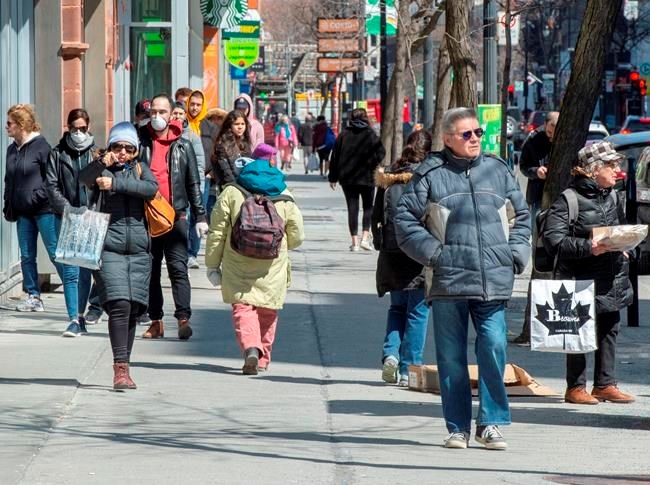OTTAWA — Battles are brewing in some cities over use of increasingly limited public space, as local governments struggle with whether to give more room for pedestrians to spread out.
The Public Health Agency of Canada says on its website that taking a walk outside is a low-risk activity for healthy people — no more dangerous than online shopping or cooking at home.
But that's only the case as long as people who venture out keep a two-metre distance from one another, which is not always possible.
Slim sidewalks, especially in urban centres, make it difficult for pedestrians to keep out of the so-called sneeze radius.
It's particularly challenging given most cities have closed parks and other outdoor spaces and encouraged people to stay in their own neighbourhoods.
Some cities have closed traffic lanes to give pedestrians more room to manoeuvre.
Calgary blocked lanes off with pylons more than a week ago so people can use the space to spread out. The city has also warned drivers to look out for pedestrians who may step onto the road.
The City of London, Ont., also brought in several new measures to make sure pedestrians are given the room they need to pass each other when out and about, including closing roads.
But some other cities worry giving pedestrians more room may draw more people out and have instead urged residents to stay inside or use less popular routes.
The disagreement has come to a head in Ottawa, where city staff denied a petition by several local councillors to close a busy downtown pedestrian route to traffic.
"We should not make it easier or more convenient for people to come outside unless for grocery trips; pharmacy; essential work and humanitarian reasons," Ottawa Mayor Jim Watson wrote on social media over the weekend.
The city's emergency services manager Anthony Di Monte said closing a road requires "intense work," including analysis and installing barriers, which the city would rather devote to supporting the public health response
If people start crowding together on the sidewalks near vital services like pharmacies, the city will consider other options, Watson said.
That has raised the ire of some of his urban colleagues on council.
"I am receiving hundreds of emails from people asking for space to walk," said one urban councillor, Catherine McKenney.
People are constantly stepping out onto the road to pass other pedestrians, which isn't safe, said McKenney.
And many of those people aren't out for recreation, they're trying to access essential services the only way they can — on foot.
"In order to give people the room to physically distance, to keep them safe, it only makes sense that you would remove a lane," McKenney said.
Another downtown councillor, Shawn Menard, who stands almost exactly two meters tall, lay down on the sidewalk to show just how difficult it is for people to stay away from each other. He took up the entire sidewalk, head to foot.
Similar discussions are playing out in cities across the country.
In Vancouver, the city has received lots of complaints about crowding in places where it's not possible to spread out and is looking into its options, according to a statement.
But those trapped between a fellow pedestrian and oncoming traffic need not panic, according to Ottawa's officer of health Dr. Vera Etches.
Passing someone briskly on the sidewalk doesn't count as close contact, and won't significantly increase your risk of exposure to COVID-19, she said.
This report by The Canadian Press was first published on April 6, 2020.
The Canadian Press


